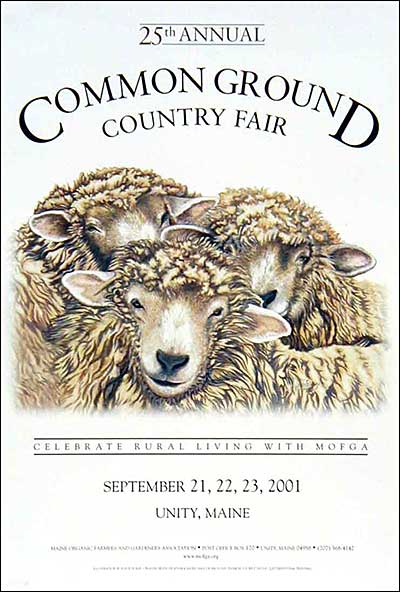Plugging Along Pays Off for Rural Maine Artist Joyce Dubay

If the three White Faced Romneys looking out from this year’s Common Ground Country Fair poster look endlessly curious and full of personality to you, that’s because they are … and because artist Joyce Dubay is well known for capturing personality in her paintings.
Joyce has combined art with rural life since she began coloring. She grew up on a rural farm just a quarter of a mile from her present home, and even when she was two or three years old, “my coloring book was my constant companion.” Whenever she had to sit and wait, she would color. “People would comment that I put a lot more into my coloring than other kids did.” At the time, she didn’t understand their observations, but as a young adult, “when I was cleaning out my mother’s attic, I found those coloring books. It really hit me – I saw what other people had commented on. Like under a chair, I would put shadows. I drew bushes with shadows. When I drew buildings, I had lines going in the direction of the boards. On a picture of a little girl with ruffles on her dress, I put in shadows and highlights to show the ruffles.”
Once she gave one of her pictures as a gift, and the recipients commented that she could do so much if she had some lessons with oils. She had always used crayons and inexpensive colored pencils before and, although she’d tried mixing colors with them, she had had trouble. “These people gave my name to a local art group for free art lessons for the winter.” She was awarded the prize and “really learned color mixing and oil as a medium. That’s when I really took off with oil.”
When watercolor became the trend in art, Joyce resisted – She didn’t want to be bothered with framing, getting glass, and so on. She also had to wait for the right time to take a class in the medium, because she picked apples in the fall and was busy with her four children and her own subsistence farm. (The family raised pigs, cows and other animals, grew its own vegetables, churned its own butter … ) “Then I decided it was time to grow, so I took a four or six week class, once a week, in watercolor. From there I went on my own, played with it.”
She had been afraid to try mixing ink with watercolor, however, until a friend suggested that she take a watercolor that was too good to throw away but not good enough to frame and try adding ink to it. She did, “and like that, I was hooked. I kept growing by adding to what I was doing.”
Next she read about painting with watercolor and adding colored pencil on top of it – the technique she used for the Romney poster. She uses water soluble colored pencils so that she can make small changes with a wet brush.
The models for the winning poster design were her next door neighbor’s sheep, just before they started lambing. While he worked all day, Joyce was asked to let the sheep out for a few hours when the weather was warm, but not to let them stay out too long because of coyotes. She would take her camera with her, because, “When I see scenes such as this, this is when I get my camera clicking.” One of the resulting photos gave her the idea for the composition, and she “picked pieces out of other photos … to get their personalities, markings … ” The ewe in the back left, for instance, is “kind of the leader of the bunch … the first to come to you and the one to follow you when you leave.”
Joyce first drew her composition in pencil, then put a yellow watercolor wash over the whole picture, “then built it up, almost like glazes … sometimes adding more yellow, sometimes orange … using blues and purples often for shadows. I pop back and forth. Most watercolor artists start with light colors and go to dark,” but because Joyce had worked in oils, she developed her “popping back and forth” style.
Joyce has painted a lot of rural scenes, especially with animals. Neighbors now use her pasture for their steers, and occasionally, when they lie down, she’ll paint them on location. If she’s lucky, she’ll finish the painting before they move.
She sells her art at sidewalk shows and at some galleries. Currently her work is at the Gallery at Stony Batter Station in Quossoc. Sometimes she enters juried shows. She just won a special merit ribbon at the Waterville Library show, and her two pieces that were in the Lewiston-Auburn Technical College show this year are now on display in Augusta – one in the office of the Speaker of the House at the State Capitol, the other at the Blaine House in the office of the First Lady.
Persistence is one key to her success, says Joyce. “Artists I work with say I’m the one who keeps plugging along. It’s like Common Ground. That has been one of those competitions that I have entered several years. You learn as you submit. You find out what gets chosen.” She says she once entered a painting of a white duck in blue water, only to realize later that the dark background wouldn’t have worked on a poster. “You’ve got to have something that will work on a T-shirt and a poster. I know people who submit [to Common Ground] two or three years, then move on. I’m a strong believer that you have to keep trying. You may have something very powerful but it doesn’t meet their needs.”

